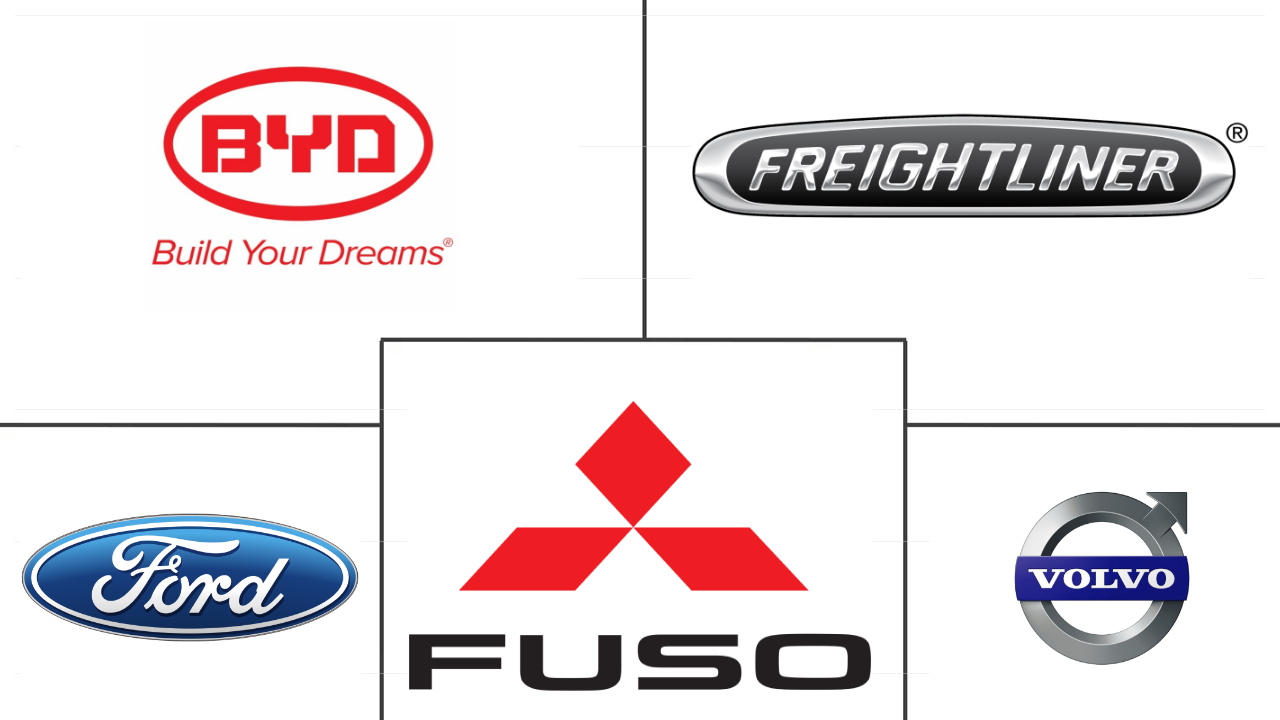Market Size of north america electric truck Industry
|
|
Study Period | 2017 - 2030 |
|
|
Market Size (2024) | USD 16.66 Billion |
|
|
Market Size (2030) | USD 79.43 Billion |
|
|
Largest Share by Fuel Category | BEV |
|
|
CAGR (2024 - 2030) | 29.74 % |
|
|
Largest Share by Country | US |
Major Players |
||

|
||
|
*Disclaimer: Major Players sorted in no particular order |
North America Electric Truck Market Analysis
The North America Electric Truck Market size is estimated at 16.66 billion USD in 2024, and is expected to reach 79.43 billion USD by 2030, growing at a CAGR of 29.74% during the forecast period (2024-2030).
16.66 Billion
Market Size in 2024 (USD)
79.43 Billion
Market Size in 2030 (USD)
113.58 %
CAGR (2017-2023)
29.74 %
CAGR (2024-2030)
Largest Segment by Vehicle Body Type
78.58 %
value share, Heavy-duty Commercial Trucks, 2023
HDT dominate the electric truck market due to their critical role in logistics, transportation of goods over long distances, and increasing adoption of electric models for sustainability.
Largest Segment by Fuel Category
57.69 %
value share, BEV, 2023
BEVs lead the electric truck market due to advancements in battery technology, regulatory incentives for zero-emission vehicles, and growing infrastructure for electric vehicle charging.
Leading Country Market
85.63 %
value share, US, 2023
The US leads the market due to its extensive commercial transportation sector, significant investments in electric vehicle technology, and supportive government policies.
Leading Market Player
68.88 %
market share, Ford Motor Company, 2023

In the niche market of the e-truck, with various model offerings of hybrid and e-trucks with a strong customer base in the US, Ford is a leader in the electric truck market in North America.
Fastest-growing Segment by Country
31.17 %
Projected CAGR, US, 2024-2030
The US is the fastest-growing segment driven by large-scale investments in EV infrastructure, increased adoption of e-trucks by logistics companies, and regulatory support for reducing emissions.
The electric commercial truck market witnesses remarkable growth, becoming a key player in sustainable transport with a growth spurt expected through 2030
- Fuel cell electric vehicles hold the largest share in the overall electric vehicle category due to the growing logistics industry, stringent emission regulations by the government, logistics companies replacing IC engines with electric fleets, and logistics companies placing more electric vehicle orders.
- Major delivery firms are beginning to replace their gas-powered fleets with electric or low-emission vehicles to combat climate change and urban pollution. Big e-commerce companies have already announced plans to turn their entire fleets electric. For instance, in March 2021, FedEx announced its global target for 50% of all newly procured vehicles to be electric by 2025, rising to 100% of all new purchases by 2030. FedEx aims to achieve carbon-neutral operations globally by 2040, with the electrification of its pickup and delivery vehicles as a major investment area.
- The US government has been proactive in enacting policies to encourage the adoption of electric vehicles. For instance, New York City relaunched its Clean Trucks Program in June 2020, which provides funding to incentivize the transition from diesel to electric models. Incentive funding between USD 12,000 and USD 185,000 is available for replacing older diesel Class 4 to Class 8 trucks. This program will be instrumental in helping the city achieve its goal of carbon neutrality by 2050.
- The demand for electric trucks is anticipated to increase as the logistics and e-commerce industries are growing rapidly. Retail e-commerce sales in the United States were estimated at USD 768 billion in 2021, with a y-o-y growth of 19.25%. In 2020, retail e-commerce sales were around USD 645 billion. Thus, the demand for electric trucks is anticipated to register a CAGR of 2.9% between 2024 and 2030.
North America registering emerging interest in electric trucks, with country-specific adoption rates influenced by regulatory incentives and the push for green logistics
- The electric truck market in North America is witnessing a notable shift toward sustainable transportation. In the United States, this market is experiencing rapid expansion, driven by substantial investments from both startups and established automotive manufacturers. The surge is further bolstered by state and federal policies, exemplified by California's Advanced Clean Trucks regulation, which mandates a rise in zero-emission truck sales.
- Increasing corporate sustainability commitments, coupled with federal incentives, are prompting fleet operators and businesses across North America to explore electric trucks as viable alternatives to traditional ICE vehicles. While Canada's electric truck market is in its early stages, it shows promise, propelled by the government's environmental goals and incentives. The Canadian government's focus on carbon emissions reduction extends to support for zero-emission vehicles (ZEVs), including electric trucks. Programs like the Incentives for Zero-Emission Vehicles Program (iZEV) and investments in charging infrastructure underscore the country's dedication to fostering an electric mobility ecosystem.
- Provinces like Quebec and British Columbia, with their own ZEV mandates and incentives, are at the forefront of electric truck adoption, particularly in urban logistics and municipal services. In Mexico, the electric truck market is still emerging, driven by concerns over urban air quality and the demand for sustainable transportation. Notably, initiatives in Mexico are concentrated in major urban centers, such as Mexico City, where pollution is a pressing issue.
North America Electric Truck Industry Segmentation
Trucks are covered as segments by Vehicle Configuration. BEV, FCEV, HEV, PHEV are covered as segments by Fuel Category. Canada, Mexico, US are covered as segments by Country.
- Fuel cell electric vehicles hold the largest share in the overall electric vehicle category due to the growing logistics industry, stringent emission regulations by the government, logistics companies replacing IC engines with electric fleets, and logistics companies placing more electric vehicle orders.
- Major delivery firms are beginning to replace their gas-powered fleets with electric or low-emission vehicles to combat climate change and urban pollution. Big e-commerce companies have already announced plans to turn their entire fleets electric. For instance, in March 2021, FedEx announced its global target for 50% of all newly procured vehicles to be electric by 2025, rising to 100% of all new purchases by 2030. FedEx aims to achieve carbon-neutral operations globally by 2040, with the electrification of its pickup and delivery vehicles as a major investment area.
- The US government has been proactive in enacting policies to encourage the adoption of electric vehicles. For instance, New York City relaunched its Clean Trucks Program in June 2020, which provides funding to incentivize the transition from diesel to electric models. Incentive funding between USD 12,000 and USD 185,000 is available for replacing older diesel Class 4 to Class 8 trucks. This program will be instrumental in helping the city achieve its goal of carbon neutrality by 2050.
- The demand for electric trucks is anticipated to increase as the logistics and e-commerce industries are growing rapidly. Retail e-commerce sales in the United States were estimated at USD 768 billion in 2021, with a y-o-y growth of 19.25%. In 2020, retail e-commerce sales were around USD 645 billion. Thus, the demand for electric trucks is anticipated to register a CAGR of 2.9% between 2024 and 2030.
| Vehicle Configuration | ||||
|
| Fuel Category | |
| BEV | |
| FCEV | |
| HEV | |
| PHEV |
| Country | |
| Canada | |
| Mexico | |
| US |
North America Electric Truck Market Size Summary
The North America Electric Truck Market is experiencing significant growth, driven by the increasing demand for sustainable transportation solutions. This expansion is largely fueled by the logistics and e-commerce sectors, which are rapidly evolving and seeking to reduce their carbon footprints. Major companies, including FedEx and prominent e-commerce giants, are transitioning their fleets from traditional internal combustion engines to electric vehicles, aligning with stringent government emission regulations and corporate sustainability goals. The market is further supported by substantial investments from both startups and established automotive manufacturers, as well as favorable state and federal policies, such as California's Advanced Clean Trucks regulation. These initiatives are encouraging fleet operators and businesses across North America to adopt electric trucks as viable alternatives to conventional vehicles.
In Canada, the electric truck market is gaining momentum, supported by government incentives and programs aimed at reducing carbon emissions. Provinces like Quebec and British Columbia are leading the charge with their own zero-emission vehicle mandates and incentives. Meanwhile, Mexico's electric truck market is emerging, driven by urban air quality concerns and the need for sustainable transportation solutions in major cities like Mexico City. Government incentives and subsidies are playing a crucial role in attracting logistics and e-commerce firms to adopt electric commercial vehicles. The market is fairly consolidated, with major players such as BYD Auto Co. Ltd., Daimler Truck North America LLC, Ford Motor Company, Mitsubishi Fuso Truck and Bus Corporation, and Volvo Group dominating the landscape. As the market continues to evolve, initiatives like Volkswagen's significant investment in electric vehicle manufacturing in North America are expected to further boost demand, with projections indicating a notable surge in electric vehicle adoption across the region by the end of the decade.
North America Electric Truck Market Size - Table of Contents
-
1. MARKET SEGMENTATION (includes market size in Value in USD and Volume, Forecasts up to 2030 and analysis of growth prospects)
-
1.1 Vehicle Configuration
-
1.1.1 Trucks
-
1.1.1.1 Heavy-duty Commercial Trucks
-
1.1.1.2 Medium-duty Commercial Trucks
-
-
-
1.2 Fuel Category
-
1.2.1 BEV
-
1.2.2 FCEV
-
1.2.3 HEV
-
1.2.4 PHEV
-
-
1.3 Country
-
1.3.1 Canada
-
1.3.2 Mexico
-
1.3.3 US
-
-
North America Electric Truck Market Size FAQs
How big is the North America Electric Truck Market?
The North America Electric Truck Market size is expected to reach USD 16.66 billion in 2024 and grow at a CAGR of 29.74% to reach USD 79.43 billion by 2030.
What is the current North America Electric Truck Market size?
In 2024, the North America Electric Truck Market size is expected to reach USD 16.66 billion.

